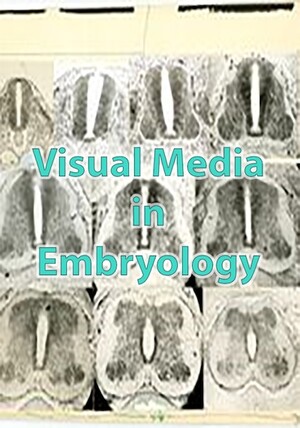As embryos are microscopic, complexly three-dimensional, and constantly transforming, investigating their dynamic form is no simple feat. Once a specimen is prepared and placed onto a microscope stage, next comes the challenge of observing and making sense of it. Embryologists, now widely referred to as developmental biologists, have achieved this primarily with pencil and paper or a camera in hand as they look through the microscope.
Particularly in the 19th and early 20th centuries, drawing was widely regarded as foundational to embryological research and a necessary skill for any successful investigation. In light of this, it is not surprising that several prominent embryologists of this time, most of whom returned to the MBL summer after summer, were also talented visual artists. Drawing was crucial for thorough observation as it required decisions be made about what details to focus on and how to represent them. Drawings were also important to record what had been seen through the microscope and ultimately served to circulate findings.
As new mediums and visualization techniques became available throughout the 20th century, they gradually made their way into embryological research as tools that could provide new views of developmental processes. At the MBL, embryologists such as E.B. Wilson, Edwin Grant Conklin, Viktor Hamburger, and John P. Trinkaus had access to the latest media, image-making instruments, and microscopes. In the late-19th and early 20th centuries, they drew from prepared slides and live specimens with a camera lucida, which allows a drawing surface to be seen when looking through the microscope. Later on, the MBL has its own photography department where researchers could have their micrographs processed and printed. Towards the end of the 20th century, microcinematography became an important research tool. During the summers, members of the MBL community would frequently gather for movie nights to collectively watch embryonic form emerging before them.
But new mediums did not replace older ones, at least not immediately. Often, they were merely added to a researcher’s existing representational toolbox. Each medium provided new possibilities and ways of seeing, but it also had its limitations. Micrographs, for example, could represent embryos in a way that came close to how they were seen through the microscope. But they often provided too much information, and, for much of the 20th century, they could only represent a single focal plane, which became a challenge when imaging a three-dimensional embryo. Because of these limitations, drawing was, and still is, essential to making sense of embryonic form. Unlike photographs, drawings can highlight certain details, and can illustrate the synthesis of observations collected over time or in several different specimens.
Seeing with Multiple Mediums
- Landecker, H. (2006). Microcinematography and the History of Science and Film. Isis, 97(1), 121–132. http://doi.org/10.1086/501105
- Brauckmann, S. (2011). Cultures of seeing embryos and cells in 3-dimensions and flatness. Studies in History and Philosophy of Biological and Biomedical Sciences, 42(4), 365–367. http://doi.org/10.1016/j.shpsc.2011.07.010
- Brauckmann, S. (2012). On Fate and Specification: Images and Models in Developmental Biology. In N. Anderson & M. R. Dietrich (Eds.), The Educated Eye: Visual Culture and Pedagogy in the Life Sciences (pp. 213–234). Dartmouth College Press.
- Maienschein, Jane. 1991. “From Presentation to Representation in E. B. Wilson’s The Cell.” Biology and Philosophy 6 (2): 227-54.
Staging Development
- Hamburger, Viktor and Howard L. Hamilton. (1951). “A Series of Normal Stages in the Development of the Chick Embryo.” Journal of Morphology 88(3): 49-92.
- Hopwood, N. (2005). Visual Standards and Disciplinary Change: Normal plates, Tables and Stages in Embryology. History of Science, 43, 239–303.
Looking at Cells
Wilson and Conklin: Tracing Cell Lineages
- Conklin, E. G. (1897). The Embryology of Crepidula: A Contribution to the Cell Lineage and Early Development of Some Marine Gasteropods. Journal of Morphology, 13(1), 1–226.
- B. Wilson, E. (1892). The cell-lineage of Nereis: A contribution to the cytogeny of the annelid body. Journal of Morphology, 6(3), 361–481.
Holtfreter: Observing Cells
- Holtfreter, Johannes. (1943). “A study of the mechanics of gastrulation Part I.” Journal of Experimental Zoology 94: 261-318.
- Holtfreter, Johannes. (1944). “A study of the mechanics of gastrulation Part II.” Journal of Experimental Zoology 95: 171-212.
- Hamburger, Viktor. (1996). “Introduction: Johannes Holtfreter, Pioneer in Experimental Embryology.” Developmental Dynamics 205: 214-216.
- Gerhart, John. (1998). “Johannes Holtfreter: January 9, 1901–November 13, 1992,” Biographical Memoirs National Academy of Sciences 73: 209–28.
Trinkaus: Filming Embryos
- Trinkaus, John Philip. "Surface activity and locomotion of Fundulus deep cells during blastula and gastrula stages." Developmental Biology 30 (1973): 68–103.
- Trinkaus, John Philip. "The yolk syncytial layer of Fundulus: Its origin and history and its significance for early embryogenesis." Journal of Experimental Zoology 265 (1993): 258–84.
Experimenting on Embryos
Exogastrulas
- Gerhart, John. (1998). “Johannes Holtfreter: January 9, 1901–November 13, 1992,” Biographical Memoirs National Academy of Sciences 73: 209–28.
Transplating Limb Buds
- Allen, Garland E. (2004). “A Pact with the Embryo: Viktor Hamburger, Holistic and Mechanistic Philosophy in the Development of Neuroembryology, 1927-1955.” Journal of the History of Biology 37: 421-474
- Hamburger, Viktor. (1934). ‘‘The Effects of Wing Bud Extirpation on the Development of the Central Nervous System in Chick Embryos.’’ Journal of Experimental Zoology 68: 449–494.
- Hamburger, Viktor. (1938). ‘‘Morphogenetic and Axial Self-differentiation of Transplanted Limb Primordia of Two-day Chick Embryos.’’ Journal of Experimental Zoology 77: 379–397

